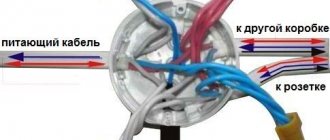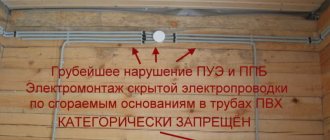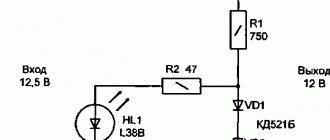Primary requirements
Among the main requirements for wiring in a bathhouse are:
- In a wooden bath, wiring should be carried out openly in cable channels, PVC corrugation, metal copper or steel pipes. In a bathhouse made of non-combustible materials (cinder block, brick, etc.) you can make hidden wiring. A cable or wire with insulation resistant to high temperatures is laid in the steam room; in practice, RKGM is most often used. In fact, here we only need to connect the lamps; if we place them in the corners, we can make the wiring in the adjacent room and make connections to them through the wall. In other rooms, they follow the shortest path to electrical appliances (for example, to a lamp).
- In the dressing room and shower (washing area), electricians recommend VVGng-LS, laid in pipes or hidden (if the walls are made of fireproof material).
- The electrical panel circuit must necessarily include circuit breakers and RCDs with an operating current of no more than 30 mA, preferably 10 mA.
- Do not install sockets and switches in a washing room or steam room. Place them in the waiting room. All electrical fittings must be mounted outside the room, at least at the entrance; the requirements are similar to the placement of sockets in the bathroom - https://samelectrik.ru/gde-i-kak-raspolozhit-rozetki-v-vannoj-komnate.html.
- The protection class of electrical sockets and switches must be no less than IP-44 (fittings with special protective covers). The protection class of bathhouse lamps must be no less than IP-54.
- It is prohibited to conduct electrical wiring above the stove.
- The premises must be grounded; it would be very good if lightning protection is also provided.
- The connection of wires can be terminal, welding, soldering or crimping with sleeves.
- Pass the cable through the walls in a metal pipe.
The requirements for wiring in a wooden bathhouse are, in principle, similar to electrical wiring in a wooden house, as we discussed in the article we referred to.
We also bring to your attention some useful tips for installing electrical wiring in a bathhouse with your own hands:
- Lay the cable to the bathhouse with a cross-section corresponding to the electrical appliances in it. Especially if you have powerful electric heaters installed, for example, an electric stove and other appliances.
- Be sure to install a protective plate made of non-combustible material between the wooden wall and the switch/socket. However, there are disputes on this score, since modern electrical installation products are already made of plastic that does not support combustion and they have a back wall, which is adjacent to the wall.
- When using cables with -ng-LS insulation for external installation in a cable channel, it is permissible not to place a non-flammable lining between the wall and the cable channel. In all other cases, be sure to separate the wires from the wall at a distance of 10 mm, or lay a strip of fireproof material.
- Retro wiring on insulators is allowed in accordance with the PUE clauses 2.1.4, 2.1.37, 2.1.39, 2.1.40, tables 2.1.2, 2.1.3.
Wires in the steam room and analysis of the main mistakes
And now about the most delicate part - the most complex electrical wiring in the bathhouse, namely in the steam room. The most important rule is that it should not be closer than 0.8 m from the chimney and heater.
In shower and steam rooms, lamps must be installed with a degree of protection IP44 and higher. And the safest option is 12-volt halogen light bulbs. But for the steam room and furnace room, it is better to take a particularly heat-resistant wire that can withstand heating up to 180˚ - brand SILFLEX Sif S = 0.25-185 sq. mm, single-core, with silicone insulation.
For safety reasons, many bathhouse attendants organize the lighting of the steam room from below - closer to the cool floor. This is most often spot lighting that can be placed under shelves, making the lighting design mysterious and unusual. Moreover, the wiring itself must be done with a special heat-resistant wire in a metal pipe.
An important point: like any equipment, sauna electrics must be inspected at least once every four years - this is a guarantee of safety. And for reference: aluminum wiring has a shelf life of 15 years, copper wiring - 20, and therefore after this period it must be replaced - if we are talking about an ordinary house, and in a bathhouse it even works in a rather aggressive environment.
Another important nuance: if you hire professional electricians, it is still advisable to understand at least some of the intricacies of electrical wiring in the bathhouse. After all, it is known that today there are many who pretend to be specialists, and if their favorite steam room burns down, they will not be found even with fire.
This is how you do the electrical wiring of a bathhouse yourself - it’s complicated, but it’s all real. And once you figure it out, everything can be done much better and safer than hiring a team of local “electricians” with experience.
What mains voltage should I choose?
Due to the different needs for providing the required level of power, the wiring in the bathhouse can power both lighting fixtures, and then in small spaces, and powerful equipment. Because of this, the type and level of voltage used differs:
- Single-phase network - used at an average level of load on the wiring in the bath from 1 to 14 kW. In this case, the entire bathhouse is powered from single-phase networks with a voltage of 220 V.
- Three-phase network - used for a wiring load in a bathhouse from 20 to 40 kW, when an electric stove, heated floor and other powerful electrical appliances (water heating boilers, pumps, etc.) are connected to the bathhouse.
- Single-phase low - allows you to power the bathhouse with a safe voltage of 12 V or 36 V, which can be used to illuminate the steam room in the bathhouse without endangering people. Relevant for small baths with low ceilings, in which the only consumer for the leash is the lighting system.
After selecting the voltage level, a wiring diagram is drawn up taking into account the locations of all consumers.
Circuit design
To draw up a wiring diagram for a bathhouse, you need to decide on the number of connection points to it - lighting devices, sockets for specific equipment, switches, etc. It should be noted that switches, like distribution boxes, are strictly prohibited from being installed in the steam room; they must be located in the locker room or dressing room. Washing is also not suitable for this due to the presence of moisture. The wiring in the steam room cannot be closer to the stove or chimney than 80 cm; these requirements must be taken into account at the design stage.
Look at the picture, here is one of the simple examples of electrifying a bathhouse. The wiring is connected to two independent terminals, each powering its own socket and a group of lighting lamps. This option will help you calmly leave the room if a short circuit occurs in one of the sections, since there are often no sources of natural light.
If you plan to install specific equipment, for example, a water heating boiler or a washing machine, you should provide a separate line for them in the wiring diagram with a larger cross-section than for a lamp. The washing machine and boiler must be installed in dry conditions. In this case, they should also be shown separately on the wiring diagram.
Recommendations from experts
Experienced electricians advise:
- Lay the cable for the bath using a hidden method. Open installation is allowed. The use of metal protective sleeves is prohibited.
- Distribution boards, switches, and sockets must not be installed in the steam room. The wiring in the steam room must be hidden.
- The electric oven is connected to a separate line equipped with automatic control units.
- Condensation should not accumulate in places where cables run.
- All devices must be grounded. The bathhouse is equipped with its own circuit.
- Electrical network components must have an appropriate protection class.
By choosing the right cable, installing the electrical network and installing devices, the owner of the bathhouse protects himself from injury, and his property from damage or destruction.
Wiring Tools
The list of necessary tools depends on what kind of wiring is planned - external or hidden. In the first case, no complex units are required; the user needs to acquire:
- screwdrivers for electrical work;
- pliers and knife;
- electrical tape;
- construction tape with a hydraulic level or laser level;
- drill.
If hidden wiring is planned in the bathhouse, the following tools will need to be added to the above list of equipment:
- a hammer drill and special crowns designed for drilling holes for sockets;
- materials for puttying, namely alabaster, lime, a mixer for preparing the mixture, a bucket or other container;
- spatulas.
Retro wiring price
The cost of installing retro wires depends on:
- The area of your home
- Number of rooms
- Saturation with electric points
- Length of wire lines
| Name of works | Units | Cost, rubles |
| Installation of retro wires 2x1.5 | m. | 80 |
| Installation of retro wires 3x1.5 | m. | 100 |
| Installation of retro wires 2x2.5 | m. | 120 |
| Installation of retro insulator | PC. | 20 |
| Installation of a retro junction box | PC. | 500 |
| Installing a retro socket | PC. | 300 |
| Installing a retro switch | PC. | 300 |
| Installing a retro pass-through switch | PC. | 500 |
| Making a platform for a retro socket | PC. | 600 |
| Installation of electrical panel 12 mod. | PC. | 4400 |
| Installation of electrical panel 24 mod. | PC. | 6800 |
| Installation of electrical panel 36 mod. | PC. | 9200 |
For example, the cost of electrical installation work in a bathhouse, photos of which are given in the article, amounted to 50,000 rubles, excluding materials. The area of the bathhouse is about 50 m2. The premises include a steam room, a shower room, a living room and two open verandas.
Selection of wires, switches, lamps
For the completed wiring diagram in the bathhouse, all its components are selected: wires, sockets, switches and lamps. The cable brand is selected in accordance with the conditions in each of the bathhouse rooms (high temperature and humidity).
Depending on the material of the current-carrying conductor, the wiring in the bathhouse can be copper or aluminum, but due to the much better mechanical and electrical parameters, the choice should be made in favor of copper wires. The main parameter for any cable brand is the wire cross-section. The cross-sectional area is selected based on the load connected to the corresponding section of the wiring.
For the steam room
The requirements of GOST R 50571.12-96 establish the following division of the steam room into zones:
Rice. 2: division of steam rooms into zones
Look at the picture, all zones are built in accordance with the location of the stove, be it electric or solid fuel. In relation to laying wiring cables and installing other equipment, these areas have the following requirements:
- The first is intended exclusively for the stove, if it is an electric heater, then the wiring for connecting it;
- The second is considered the most loyal in terms of wiring requirements; no standards are provided for it;
- For the third zone, there are requirements for equipment that must normally withstand temperatures of 125°C or more, and wiring of 170°C or more;
- Only lamps, sensors and regulators can be installed in the fourth zone, but their wiring is selected as for the previous bath zone.
For internal electrical wiring in the steam room, heat-resistant cables should be used, for example, flexible copper RKGM, PVKV, PRKS or PMTK.
Lamps in the steam room must have a metal body to which grounding is connected, a sealed glass shade with a degree of protection of at least IP24. You should not choose models with a plastic body or parts to connect lamps, as they can melt and deform, causing moisture to penetrate inside.
Dressing room, locker room, rest room
In other functional areas of the bathhouse, the use of VVGng power non-flammable cables is allowed.
Important! To organize internal electrical wiring in bathhouses, universal flat wires (PUNP) are not used, which can become the main cause of a fire hazard.
When choosing circuit breakers for protection against power surges in the network, first of all it is worth determining their operating power. The main machine must have maximum power; for auxiliary devices this figure is significantly reduced.
To set the limit value of the machine for disconnecting from the network, the current strength in the circuit and in its specific section is taken into account. For example, if the current strength in a section of the circuit is 18A, then the maximum permissible threshold of the main circuit breaker is 20A.
No less important for the protection of electrical appliances is a residual current device (RCD). According to the PUE, the RCD response threshold should be from 25 to 30 mA.
How to choose wires and sockets based on load?
For example, you are going to connect two 100 W light bulbs, plug in a 1 kW electric kettle and a 4 kW electric heated floor. Thus, to calculate the cross-section, add up the power consumption of all consumers P = 0.1 + 0.1 + 1 + 4 = 5.2 kW. To the resulting power value it is necessary to add a 20 - 30% safety margin, for our example we get 6.24 kW.
To select a specific cross-sectional value for wiring based on the consumer’s power or the amount of electric current, you must use our calculator or table data.
Table: selection of wire cross-section
Look at the table; for a power of 6.24 kW, copper wiring with a core cross-section of 4 mm² or aluminum wiring of 6 mm² is suitable. If you have drawn up a power supply diagram with separation of wiring for different consumers, then it is advisable to perform the procedure for calculating the cross-section for each individual section, but the material of the conductor for the wiring must be the same.
The socket, like the wiring, has a certain current carrying capacity. Therefore, the selection of connection points to the mains voltage should be made in accordance with the devices being connected. For example, for a refrigerator it is enough to install a 10 A socket, but for a boiler, depending on the power, you will need 16 or 24 A.
Which type to use
In accordance with GOST R 50571.12-96, the steam room of the bath is conventionally divided into several zones:
- Zone 1 is intended for the installation of electric ovens;
- Zone 2 does not have any specific requirements for the thermal resistance of equipment;
- Zone 3 imposes requirements on the heat resistance of equipment - it must withstand temperatures up to 250 degrees, and cable insulation - up to 170 degrees;
- Zone 4 is intended for installation of temperature sensors and furnace control points. The electrical cable in this area must withstand temperatures up to 170 degrees.
The cable for the steam room in the bathhouse is selected in accordance with the above requirements.
So, in the third and fourth zones, the cable insulation must be resistant to temperatures of at least 170 degrees. In this case, the following will do:
- Stranded copper wires PRKA, RKGM, PRKS, PVKV, since they can withstand up to 180 degrees;
- PMTC can withstand temperatures up to 200 degrees; it can be either single-wire or multi-wire;
- The imported cable OLFLEX HEAT 205 can withstand temperatures up to 200 degrees.
For other rooms of the bathhouse building, any of the above wires can be used.
The equipment in each zone has certain requirements.
Methods of conducting electricity into the bathhouse
To conduct electricity to the bathhouse building, it is necessary to ensure its delivery from the central switchboard through the incoming power cable. You can lay the cable to the bathhouse in one of two ways: underground or over the air.
Underground installation method
The safest and most labor-intensive way to lay power cables, which requires preliminary preparation of an earthen trench, is from the power source to the bathhouse.
For underground input, a VBBShV cable with copper conductors with a cross-section of 10 to 16 kV is used. mm. It has increased strength, safety and durability. Protection from mechanical damage and biological effects is provided by heat-resistant insulation and steel braiding.
For underground cable laying, polypropylene pipes are used that are resistant to corrosion and freezing; metal pipes can be used when installing cables on poles or wall structures no more than 180 cm in height.
The technology for laying cables underground is as follows:
- Preparing an earthen trench up to 70 cm deep. Filling the bottom (10 cm) with a sand layer. Cable laying and re-filling with sand.
- The introduction of the cable into the building through a metal input sleeve, which is used to protect against damage to the insulation during shrinkage of the walls of the bathhouse.
- The cable is stripped of insulation before connecting to the machine in the input panel. Next, grounding and protection against lightning strikes are performed.
Important! Wavy laying of the cable in the trench will prevent its mechanical damage as a result of soil movements or shrinkage of the building.
Air installation method
Installation by air is more accessible and cheaper in terms of labor and financial costs, but it is not durable due to susceptibility to damage and deformation.
If you need to connect a wire from a house to a bathhouse, then you need to correctly calculate the maximum permissible distance between objects. When buildings are located at a significant distance from each other, aerial laying is irrational, since the risk of cable damage increases under unfavorable climatic conditions.
Methods of summing up
Before planning the process of installing electrical wiring in the bathhouse, you need to run a power cable to it. There are only two ways to do this:
The advantages of the air method include its low cost and speed of installation. In this case, SIP 4 cable is used.
In order to secure the cable in the external wall of the bathhouse, it must be placed in a corrugated pipe or plastic box. A box with a circuit breaker is installed at the SIP cable entry point.
Conducting underground is quite difficult and expensive, so in this case they use the VB6Shv cable model. The advantage of this method is that it protects the cable from damage.
It is better to install electrical wiring inside the bathhouse using an open method, since it is safer and more convenient. In this case, the wiring lines are quite easy to view, and there are no difficulties during the replacement or repair process.
Let us consider in more detail the overhead and underground method of connecting the cable to the bathhouse.
Air supply method
Laying a cable through the air is more dangerous than underground, since in this case it will be constantly exposed to tests: weather changes, precipitation, ultraviolet radiation, wind - all this adversely affects the structure of the cable.
In this regard, it must be strong enough and have good protection from all weather vagaries.
In order to run a wire from a house to a bathhouse, the following are usually used:
- Cable without insulating layer;
- SIP cable with an insulating layer.
It is best to opt for the second option, since the SIP is covered with a dense polyethylene layer, which protects it from any influences, and its core is made of aluminum. It is also quite rigid, so it does not require the installation of an additional frame.
So, if you decide to conduct a cable to the bathhouse by air, you should know several rules and requirements for this process:
- The distance from the cable to the roadway must be at least 6 m;
- The distance from the cable to the pedestrian part must be at least 3.5 m;
- In the case where the cable is lowered from a support exceeding 25 meters, it is necessary to install an additional support;
- The minimum height of the wire entry in a bathhouse building is 2-3 m.
SIP4 is usually used as a conductive cable for the overhead installation method, the name of which stands for self-supporting insulating wire. SIP4 does not have a support cable.
The cross-section of the aluminum conductors of the SIP4 cable should be equal to 16 sq. mm. If you plan to carry out two-phase input, then the cable must be two-core. If three-phase - four-wire.
To install a cable using a steel pipe, you must follow these rules:
- In order to prevent moisture from entering the pipe, it is necessary to bend its upper end into a half ring;
- The lower end of the steel pipe must be fixed at an angle of 5-15 degrees, inclined towards the street;
- It is necessary to paint the pipe with high quality, and also make a hole at the very bottom so that the condensate flows out freely;
- The pipe is attached to the wall using clamps, and to the roof using steel braces and bolts.
Underground connection method
The most reliable, but not always appropriate way. As mentioned earlier, the underground method of connecting the cable to the bathhouse requires quite a lot of material costs.
However, it is with this method of installation that the cable is maximally protected from damage and does not require replacement or repair for a long time.
The cable used for underground installation is VBBShV, an armored cable with four copper cores.
The cross-section of all copper conductors is equal to 10 mm2. There is a metal braid between the inner and outer shell, which is why VBBShV is stronger than a SIP cable.
In the process of laying a cable underground, the first step is to dig a trench, the depth of which varies from 0.7 to 1.2 m. Then you need to pour 10 cm of sand at the bottom of the trench and lay the cable on it, which is also covered with sand on top.
For vertical cable laying, you can use metal pipes and angles, but this is strictly prohibited when laying the cable horizontally, as it can lead to the formation of condensation.
Installation process in a bath or sauna
After installing the cable, the process of installing electrical wiring in a bathhouse or sauna can be divided into several stages:
- Installation of electrical panel;
- Wiring in the bathhouse from the panel;
- Installation of lighting fixtures and their connection to wiring;
- Installation of sockets and their connection to wiring;
- Installation of switches and their connection to wiring.
Stage 1: installation of electrical panel
The entire energy system of the bath structure will be powered from this device - the electrical panel.
During its installation, you must comply with some requirements and rules, including location:
- It is necessary to ensure unobstructed access to the electrical panel;
- Under no circumstances should the shield be placed in a steam room or other rooms with a high fire hazard;
- The room in which the shield will be located must be well ventilated and lit.
In most cases, the shield is located in the rest room, since this is the safest room in the entire bathhouse building. The minimum distance between the floor and the top of the shield is 1.5 m. It is best to route the cables from the shield through a corrugated pipe.
Important! It is mandatory to place a diagram of the electrical wiring of the bathhouse building next to the panel.
Stage 2: wiring
In order to proceed directly to the internal wiring, the wiring diagram must be ready. It also determines how the wires will be laid.
- The open method is more practical, since when repairing or replacing cables you will not have to damage the walls, since the wiring is very easy to see.
- The hidden method is practical from an aesthetic point of view, because in this case the wires are not noticeable and do not spoil the overall picture of the interior. However, if the need for repairs arises, you will have to open the walls and ceilings, and this is quite expensive and time-consuming.
At this stage, wiring is being installed in all bath rooms. It is best to stick to the open method of laying wires, but in this case they should be placed in a corrugation made of non-flammable materials. In order to connect the wires to the sockets, you need to make a U-shaped elbow and insert the wires from the bottom.
After drawing a line in each of the bath rooms, as well as connecting it to lamps and electrical appliances, you need to connect to the circuit breaker.
If you decide to do the electrical wiring in the bathhouse yourself, then follow these recommendations:
- The wiring coming from the shield must be solid;
- For a bathhouse made of logs or wood, it is best to use an open wiring method, but in no case should the wire be placed in a PVC pipe;
- For a brick bathhouse, you can make hidden wiring by hiding the wires behind a layer of plaster;
- It is not recommended to place wiring in conspicuous places, such as opposite doors or near metal pipes and radiators;
- It is important to note that there should be no twisting of the wires or kinks. The wires are located either strictly vertically or strictly horizontally;
- Due to high humidity, sockets and switches should not be placed in the steam room, since over time condensation accumulates inside electrical appliances, and this inevitably leads to a short circuit;
- Under no circumstances should wires be placed near or above the stove;
- Do not place wires in metal or pipe sheaths.
Stage 3: connecting lamps
It is necessary to carefully consider the choice of lamps. Their protection class must be at least IP44, and their power must not exceed 70-75 W. The lampshades are usually made of thick tempered glass, and the body itself is made of ceramic. The lamp body is connected to the protective core of the wire, so if it is made of plastic, deformation cannot be avoided.
It is recommended to place lamps on the walls, since placement on the ceiling is not the best, because this is where hot air accumulates. For a steam room, a minimum voltage of 12 (V) is usually used, and therefore there is a need for step-down transformers. It is unacceptable to place them in the steam room.
Stage 4: connecting sockets
Under no circumstances should sockets be placed in the steam room. It is best to give them a separate area in the safest room, such as a rest room or vestibule. The level of protection of sockets in a bathhouse must be at least IP44; the presence of protective covers on them is an advantage. The minimum height at which sockets can be placed is 90 cm.
There is a difference in a bathhouse and a steam room
We have already said above that the wiring in the steam room differs in a number of important points from the electrical wiring in the bathhouse.
ADVICE! It will be easiest for those bathhouse owners who already included the wiring in the construction project. Because this is the only way compliance with standards will not be a matter of chance.
In the steam room
Electrical wiring in the steam room: no wires
there are no wires - they go from the outside, and go inside exclusively to connect the lamps.
The question arises: is it necessary to use more expensive heat-resistant wires for electrical wiring in the steam room of a bathhouse? For those who have no way out and have to conduct wiring inside the walls of the steam room - yes, definitely. If you follow the rules - only through the wall to the lamp, then it is a matter of ease of replacing the wire.
The fact is that simple PVC insulation will inevitably collapse in the area that is exposed to high temperatures . This is usually at the wire entrance to the lamp. Therefore, it is recommended to make this area heat-resistant.
In a steam room with an electric oven
The electric furnace is used only in the sauna (because we question the ability of electric furnaces without a steam generator to create a Russian bath mode).
Power calculations are usually done in a simplified manner, based on the cubic capacity of the room, based on the ratio of 1-1.5 kilowatts per cubic meter. Therefore, it is enough for you to proceed from one or one and a half volume of the steam room. Let's assume that a pair room of 1.8*1.4*2.1 (DSHV) is given. Its volume is 5.3 cubic meters. Consequently, the furnace power is from 5 to 8 kW. And this is still a small steam room!
It is clear that such a power plant is not installed on a regular outlet (here the current strength is 23-36 A, and a regular outlet can withstand 10-16 A). The wire is led outside and connected to a power outlet (they come in different capacities).
Heat-resistant wires of the required cross-section are included with the stove itself , so you just need to take them out and connect them.
BY THE WAY! A grounding plug requires a ground connection to the outlet, this is not new, is it?











